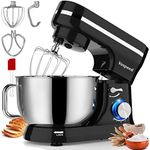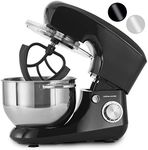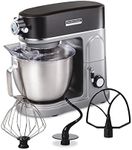Buying Guide for the Best Budget Stand Mixer
When choosing a stand mixer, it's important to consider your specific needs and how you plan to use the mixer. Stand mixers are versatile kitchen appliances that can make baking and cooking much easier, but selecting the right one involves understanding various features and specifications. By focusing on the key specs, you can find a stand mixer that fits your cooking style and kitchen requirements.Motor PowerMotor power in a stand mixer is measured in watts and indicates how powerful the mixer is. This is important because a more powerful motor can handle tougher doughs and larger batches without straining. Motor power can range from around 250 watts to over 1000 watts. For light tasks like whipping cream or mixing cake batter, a lower wattage (250-500 watts) is sufficient. For heavier tasks like kneading bread dough, a higher wattage (500-1000 watts) is preferable. Consider what types of recipes you plan to make most often to determine the right motor power for you.
Bowl CapacityBowl capacity refers to the volume of the mixing bowl, usually measured in quarts or liters. This is important because it determines how much you can mix at one time. Smaller bowls (3-4 quarts) are suitable for small batches or single recipes, while larger bowls (5-7 quarts) are better for larger batches or multiple recipes. If you frequently bake for a family or entertain guests, a larger bowl might be more convenient. However, if you mostly cook for one or two people, a smaller bowl may be more practical.
Speed SettingsSpeed settings on a stand mixer allow you to control how fast the mixer operates. This is important for achieving the right consistency for different recipes. Most mixers offer a range of speeds, typically from 3 to 12 settings. Basic tasks like stirring or mixing can be done at lower speeds, while whipping or kneading may require higher speeds. Consider the types of recipes you make and whether you need precise control over mixing speeds to choose the right number of speed settings.
AttachmentsAttachments are additional tools that can be used with a stand mixer to perform various tasks. Common attachments include a flat beater, dough hook, and wire whisk. These are important because they expand the functionality of the mixer. Some mixers also offer optional attachments like pasta makers or meat grinders. If you plan to use your mixer for a variety of tasks, look for a model with a good selection of attachments. Consider what tasks you want to perform with your mixer to determine which attachments are necessary for you.
Build QualityBuild quality refers to the materials and construction of the stand mixer. This is important because a well-built mixer will be more durable and stable during use. Mixers can be made from plastic, metal, or a combination of both. Metal mixers tend to be more durable and stable, but they can also be heavier. If you plan to use your mixer frequently or for heavy-duty tasks, a model with a sturdy build is advisable. Consider how often and for what purposes you will use the mixer to decide on the appropriate build quality.










